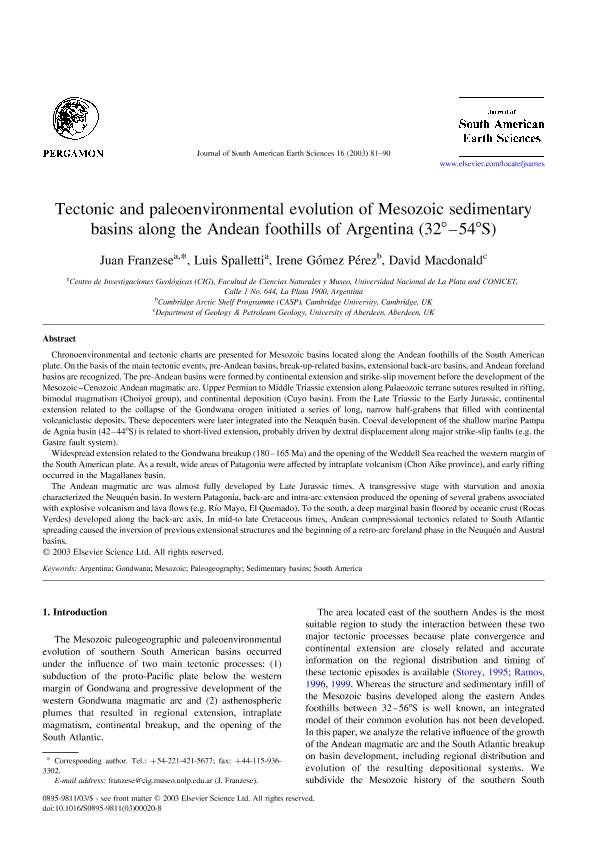Artículo
Tectonic and paleoenvironmental evolution of Mesozoic sedimentary basins along the Andean foothills of Argentina (32°-54°S)
Fecha de publicación:
04/2003
Editorial:
Pergamon-Elsevier Science Ltd
Revista:
Journal of South American Earth Sciences
ISSN:
0895-9811
Idioma:
Inglés
Tipo de recurso:
Artículo publicado
Clasificación temática:
Resumen
Chronoenvironmental and tectonic charts are presented for Mesozoic basins located along the Andean foothills of the South American plate. On the basis of the main tectonic events, pre-Andean basins, break-up-related basins, extensional back-arc basins, and Andean foreland basins are recognized. The pre-Andean basins were formed by continental extension and strike-slip movement before the development of the Mesozoic-Cenozoic Andean magmatic arc. Upper Permian to Middle Triassic extension along Palaeozoic terrane sutures resulted in rifting, bimodal magmatism (Choiyoi group), and continental deposition (Cuyo basin). From the Late Triassic to the Early Jurassic, continental extension related to the collapse of the Gondwana orogen initiated a series of long, narrow half-grabens that filled with continental volcaniclastic deposits. These depocenters were later integrated into the Neuquén basin. Coeval development of the shallow marine Pampa de Agnia basin (42-44°S) is related to short-lived extension, probably driven by dextral displacement along major strike-slip faults (e.g. the Gastre fault system). Widespread extension related to the Gondwana breakup (180-165 Ma) and the opening of the Weddell Sea reached the western margin of the South American plate. As a result, wide areas of Patagonia were affected by intraplate volcanism (Chon Aike province), and early rifting occurred in the Magallanes basin. The Andean magmatic arc was almost fully developed by Late Jurassic times. A transgressive stage with starvation and anoxia characterized the Neuquén basin. In western Patagonia, back-arc and intra-arc extension produced the opening of several grabens associated with explosive volcanism and lava flows (e.g. Ŕo Mayo, El Quemado). To the south, a deep marginal basin floored by oceanic crust (Rocas Verdes) developed along the back-arc axis. In mid-to late Cretaceous times, Andean compressional tectonics related to South Atlantic spreading caused the inversion of previous extensional structures and the beginning of a retro-arc foreland phase in the Neuquén and Austral basins. © 2003 Elsevier Science Ltd. All rights reserved.
Palabras clave:
Argentina
,
Gondwana
,
Mesozoic
,
Paleogeography
,
Sedimentary Basins
,
South America
Archivos asociados
Licencia
Identificadores
Colecciones
Articulos(CIG)
Articulos de CENTRO DE INVEST.GEOLOGICAS (I)
Articulos de CENTRO DE INVEST.GEOLOGICAS (I)
Citación
Franzese, Juan Rafael; Spalletti, Luis Antonio; Gómez Pérez, Irene; Macdonald, David; Tectonic and paleoenvironmental evolution of Mesozoic sedimentary basins along the Andean foothills of Argentina (32°-54°S); Pergamon-Elsevier Science Ltd; Journal of South American Earth Sciences; 16; 1; 4-2003; 81-90
Compartir
Altmétricas




